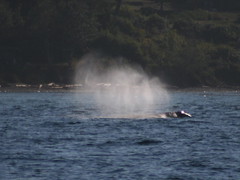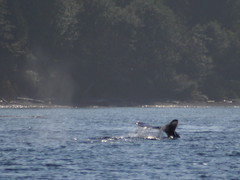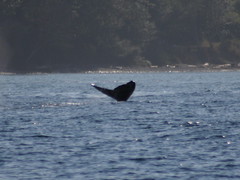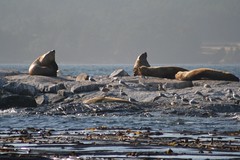






The afternoon trip on the Ocean Magic II led us south to Agate Bay, Washington State. There we found a gray whale foraging in the shallow water. Adult gray whales get up to 15m and weigh upwards of 40 tons. These whales feed on small crustaceans such as amphipods, and tubeworms found in bottom sediments. It has a series of 130-180 fringed overlapping plates hanging from each side of the upper jaw. Gray whales dive to the bottom, roll on thier sides and draw bottom sediments and water into thier mouths. As a whale closes its mouth, water and sediments are expelled through the baleen plates, which trap food on the inside near the tongue to be swallowed. Gray whale makes one of the longest of all mammalian migrations, averaging 10,000-14,000 miles (16,000-22,530 km) round trip. The southward journey from the Bering and Chukchi Seas to their Baja California, Mexico, breeding lagoons takes 2-3 months. The whales remain in the lagoons for 2-3 months, allowing the calves to build up a thick layer of blubber to sustain them during the northward migration and keep them warm in the colder waters. The large blows of mist in the afternoon light created a beautiful sight. On the way back to Victoria we stopped at Race Rocks to view the many types of seals and sea lions hauled out in the sun.













No comments:
Post a Comment